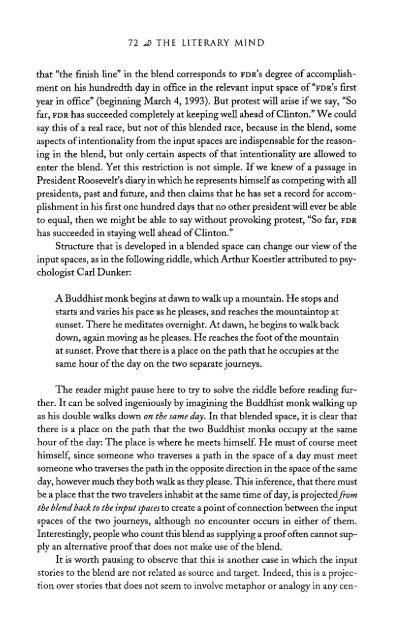The Literary Mind.pdf
The Literary Mind.pdf
The Literary Mind.pdf
Create successful ePaper yourself
Turn your PDF publications into a flip-book with our unique Google optimized e-Paper software.
72 THE LITERARY MIND<br />
that "the finish line" in the blend corresponds to FDR'S degree of accomplishment<br />
on his hundredth day in office in the relevant input space of "FDR'S first<br />
year in office" (beginning March 4, 1993). But protest will arise if we say, "So<br />
far, FDR has succeeded completely at keeping well ahead of Clinton." We could<br />
say this of a real race, but not of this blended race, because in the blend, some<br />
aspects of intentionality from the input spaces are indispensable for the reasoning<br />
in the blend, but only certain aspects of that intentionality are allowed to<br />
enter the blend. Yet this restriction is not simple. If we knew of a passage in<br />
President Roosevelt's diary in which he represents himself as competing with all<br />
presidents, past and future, and then claims that he has set a record for accomplishment<br />
in his first one hundred days that no other president will ever be able<br />
to equal, then we might be able to say without provoking protest, "So far, FDR<br />
has succeeded in staying well ahead of Clinton."<br />
Structure that is developed in a blended space can change our view of the<br />
input spaces, as in the following riddle, which Arthur Koestler attributed to psychologist<br />
Carl Dunker:<br />
A Buddhist monk begins at dawn to walk up a mountain. He stops and<br />
starts and varies his pace as he pleases, and reaches the mountaintop at<br />
sunset. <strong>The</strong>re he meditates overnight. At dawn, he begins to walk back<br />
down, again moving as he pleases. He reaches the foot of the mountain<br />
at sunset. Prove that there is a place on the path that he occupies at the<br />
same hour of the day on the two separate journeys.<br />
<strong>The</strong> reader might pause here to try to solve the riddle before reading further.<br />
It can be solved ingeniously by imagining the Buddhist monk walking up<br />
as his double walks down on the same day. In that blended space, it is clear that<br />
there is a place on the path that the two Buddhist monks occupy at the same<br />
hour of the day: <strong>The</strong> place is where he meets himself. He must of course meet<br />
himself, since someone who traverses a path in the space of a day must meet<br />
someone who traverses the path in the opposite direction in the space of the same<br />
day, however much they both walk as they please. This inference, that there must<br />
be a place that the two travelers inhabit at the same time of day, is projected from<br />
the blend back to the input spaces to create a point of connection between the input<br />
spaces of the two journeys, although no encounter occurs in either of them.<br />
Interestingly, people who count this blend as supplying a proof often cannot supply<br />
an alternative proof that does not make use of the blend.<br />
It is worth pausing to observe that this is another case in which the input<br />
stories to the blend are not related as source and target. Indeed, this is a projection<br />
over stories that does not seem to involve metaphor or analogy in any cen-















